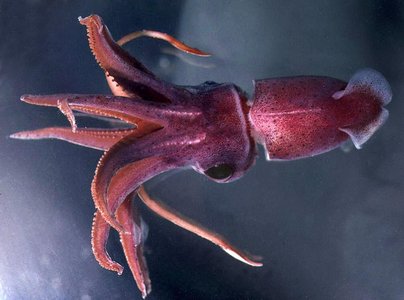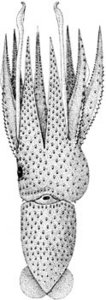Histioteuthis oceani
Richard E. Young and Michael VecchioneIntroduction
Histioteuthis oceani is one of three species of histioteuthids that has tubercles. It is found throughout much of the tropical Pacific but records are few.
Characteristics
- Head
- Beaks: Descriptions can be found here: Lower beak; upper beak.
- Beaks: Descriptions can be found here: Lower beak; upper beak.
- Tubercles
- Arms I with 25-36 tubercules; arms II with 23-30 tubercules and arms III with 17-21.
- Length of tubercule-rows 46-83% of arm lengths.
- Photophores
- Arms IV with 6 longitudinal series on arm base in first 1-3 diagonal rows then decreases to 5 series distally.
Comments
More details of the description can be found here.Species of the miranda-group are distinguished by the following characteristics:
- Tubercles
- Present on dorsal midline of mantle and aboral surfaces of arms I-III.
- Photophores
- In 5-6 series on arm IV base.
- Compound photophores of uniform, medium size on anterior 3/4 of ventral mantle.
H. oceani is most easily separated from the other member of the miranda-group, H. miranda, by (1) the greater number of photophores on the base of arms IV (6 vs 5), (2) the greater number of tubercles on each arm, (3) the greater length of the tubercle rows on the arms, and the undivided buccal connectives to arms II.
The above data are from Voss, et al. (1998).
Life History
Largest known female is 70 mm ML (immature); only known mature male is 50 mm ML (Voss et al., 1998). Maturity-related photophores were not found in these specimens. Young H. oceani of 12 mm ML have well-developed tubercules (Voss et al., 1998).
Distribution
Vertical distribution
During a study of vertical distribution off Hawaii, Two captures of H. oceani were made during the day at depths of 575 and 665 m. Four night captures were made from 165-275 m.


Figure. Vertical distribution chart of H. oceani, Hawaiian waters. Captures were made with both open and opening/closing trawls. Bars - Fishing depth-range of opening/closing trawl. Circle - Modal fishing depth for either trawl. Square - Midpoint of trawl where no modal depth was present. Blue color - Night captures. Yellow color - Day captures.
Geographical distribution
Type locality: Eastern Tropical Pacific, SE of the Galapagos, 2°33'S, 89°44'W. H. oceani is known from relatively few localities spread across the tropical Pacific. A few records of squid of uncertain identity that may belong to this species, however, are also known from the Indian Ocean (Voss, et al, 1998).
References
Voss, N. A. 1969. A monograph of the Cephalopoda of the North Atlantic: The family Histioteuthidae. Bull. Mar. Sci., 19: 713-867.
Voss, N.A., K. N. Nesis, P. G. Rodhouse. 1998. The cephalopod family Histioteuthidae (Oegopsida): Systematics, biology, and biogeography. Smithson. Contr. Zool., 586(2): 293-372.
Young, R. E. 1978. Vertical distribution and photosensitive vesicles of pelagic cephalopods from Hawaiian waters. Fish. Bull., 76: 583-615.
Title Illustrations

| Scientific Name | Histioteuthis oceani |
|---|---|
| Location | off Hawaii |
| Specimen Condition | Live Specimen |
| View | dorsal |
| Image Use |
 This media file is licensed under the Creative Commons Attribution-NonCommercial License - Version 3.0. This media file is licensed under the Creative Commons Attribution-NonCommercial License - Version 3.0.
|
| Copyright |
© 2000
Richard E. Young

|
| Scientific Name | Histioteuthis oceani |
|---|---|
| Location | 21°N, 158°W |
| Reference | from Voss, N.A., K. N. Nesis, P. G. Rodhouse. 1998. The cephalopod family Histioteuthidae (Oegopsida): Systematics, biology, and biogeography. Smithson. Contr. Zool. 586(2):293-372. |
| Sex | Male |
| Life Cycle Stage | mature |
| View | ventral |
| Size | 50 mm GL |
About This Page
Richard E. Young

University of Hawaii, Honolulu, HI, USA
Michael Vecchione

National Museum of Natural History, Washington, D. C. , USA
Page copyright © 2013 Richard E. Young and Michael Vecchione
 Page: Tree of Life
Histioteuthis oceani .
Authored by
Richard E. Young and Michael Vecchione.
The TEXT of this page is licensed under the
Creative Commons Attribution-NonCommercial License - Version 3.0. Note that images and other media
featured on this page are each governed by their own license, and they may or may not be available
for reuse. Click on an image or a media link to access the media data window, which provides the
relevant licensing information. For the general terms and conditions of ToL material reuse and
redistribution, please see the Tree of Life Copyright
Policies.
Page: Tree of Life
Histioteuthis oceani .
Authored by
Richard E. Young and Michael Vecchione.
The TEXT of this page is licensed under the
Creative Commons Attribution-NonCommercial License - Version 3.0. Note that images and other media
featured on this page are each governed by their own license, and they may or may not be available
for reuse. Click on an image or a media link to access the media data window, which provides the
relevant licensing information. For the general terms and conditions of ToL material reuse and
redistribution, please see the Tree of Life Copyright
Policies.
Citing this page:
Young, Richard E. and Michael Vecchione. 2000. Histioteuthis oceani . Version 01 January 2000 (under construction). http://tolweb.org/Histioteuthis_oceani/19807/2000.01.01 in The Tree of Life Web Project, http://tolweb.org/











 Go to quick links
Go to quick search
Go to navigation for this section of the ToL site
Go to detailed links for the ToL site
Go to quick links
Go to quick search
Go to navigation for this section of the ToL site
Go to detailed links for the ToL site